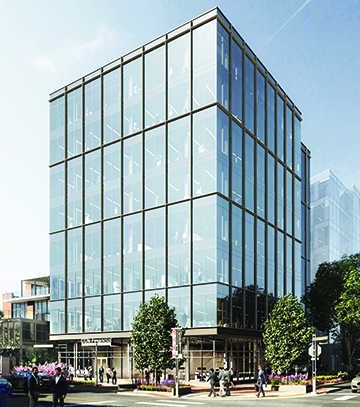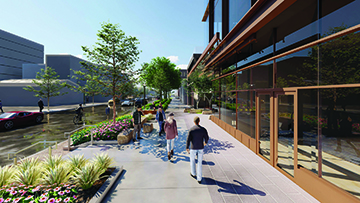
by Mark Smiley | Jul 23, 2021 | Editorials
Multi-Sensory Art Experience In The Hangar Until Sept. 26
by Mark Smiley

Van Gogh Alive: Playing at The Hangar at Aurora’s Stanley Marketplace through September 26. Buy tickets at denvercenter.org.
The Denver Center for the Performing Arts, Stephen Lindsay & Brett Sirota and Andrew Kay Management in partnership with Grande Experiences present Van Gogh Alive, a large-scale, multi-sensory experience that is promoted as entertaining for the entire family. Van Gogh’s works have been displayed and enjoyed around the world for over a century. For a limited time only — through September 26 in The Hangar at Aurora’s Stanley Marketplace — audiences have an opportunity to experience Van Gogh’s artistry and venture into his world.
With a career that ran a little over a decade, he produced an astonishing amount of work: 1,000 drawings, 150 watercolors, 9 lithographs, an etching, and over 900 paintings. Van Gogh is today one of the most popular of the Post-Impressionist painters, although he was not widely appreciated during his lifetime. He is now famed for the great vitality of his works which are characterized by expressive and emotive use of brilliant color and energetic application of impastoed paint. The traumas of his life, documented in his letters, have tended to dominate and distort modern perceptions of his art. This experience walks you through the different paintings and the mood and year in which they were painted. Pay particular attention to the quotes from Van Gogh that appear throughout the exhibit during the show.
 Created by Grande Experiences, Van Gogh Alive, a large-scale, COVID-Safe, multi-sensory digital art experience, gives visitors the unique opportunity to immerse themselves into Van Gogh’s artistry. Traditions of tiptoeing through silent galleries and viewing paintings from afar in quiet contemplation are forgotten as visitors find themselves interacting with art in ways they never imagined. From start to finish, visitors are surrounded by a vibrant symphony of light, color, sound and fragrance that has been called an “unforgettable” multi-sensory experience. Van Gogh’s masterpieces come to life, giving visitors the sensation of walking right into his paintings, a feeling that is simultaneously enchanting, entertaining and educational. Adults and children delight in the super-scale show, viewing artworks from new angles and discovering unique perspectives. But don’t just take their word for it: experience it for yourself!
Created by Grande Experiences, Van Gogh Alive, a large-scale, COVID-Safe, multi-sensory digital art experience, gives visitors the unique opportunity to immerse themselves into Van Gogh’s artistry. Traditions of tiptoeing through silent galleries and viewing paintings from afar in quiet contemplation are forgotten as visitors find themselves interacting with art in ways they never imagined. From start to finish, visitors are surrounded by a vibrant symphony of light, color, sound and fragrance that has been called an “unforgettable” multi-sensory experience. Van Gogh’s masterpieces come to life, giving visitors the sensation of walking right into his paintings, a feeling that is simultaneously enchanting, entertaining and educational. Adults and children delight in the super-scale show, viewing artworks from new angles and discovering unique perspectives. But don’t just take their word for it: experience it for yourself!
Van Gogh Alive is a multi-sensory art experience that involves high-level cinema-quality sound, large scale moving images, theater level lighting and at times loud abrupt sounds. Individual visit times vary, but most visitors anticipate spending approximately 60 minutes in the experience. The main feature of the exhibition lasts around 45 minutes.
 The Denver Center for the Performing Arts, denvercenter.org, is the only authorized ticket provider for this production. There is no minimum age requirement and all attendees need a ticket. The experience is open Sunday, Tuesday, Wednesday, and Thursday from 10 a.m. to 8 p.m. and Friday and Saturday from 10 a.m. to 9 p.m. Follow this experience on social media: #VanGogh Alive and @DenverCenter.
The Denver Center for the Performing Arts, denvercenter.org, is the only authorized ticket provider for this production. There is no minimum age requirement and all attendees need a ticket. The experience is open Sunday, Tuesday, Wednesday, and Thursday from 10 a.m. to 8 p.m. and Friday and Saturday from 10 a.m. to 9 p.m. Follow this experience on social media: #VanGogh Alive and @DenverCenter.

by Mark Smiley | Jul 23, 2021 | Main Articles
This Month Broe To Begin Construction Of Phased $35 Million Street Conversion By Bulldozing Buildings At 2nd Ave. And Clayton
by Glen Richardson
Broe Real Estate Group — which owns the bulk of the east side of Clayton St. in Cherry Creek North — is restarting the pandemic-paused transformation of the north-south street this month by bulldozing structures on the southeast corner of 2nd Ave. at Clayton.
Leveling of the structures will make way for construction of an eight-story, 76,000-sq.-ft. high-rise that will feature both retail space and commercial offices.
Building site construction fencing was installed along the southeast side of Clayton at 2nd Ave. in mid-July. Two existing two-story structures, one at 200 Clayton — location of Planet Laboratories Aveda Cherry Creek for years — and the other at 210 Clayton — where Show Of Hands was a longtime tenant — are slated to be demolished.
Mega Makeover

Starting Structure: Rendering of eight-story building that will be the first built. Existing structures at 200 and 210 Clayton St. will be bulldozed to make way for the building.
Broe has been based in Cherry Creek since 1983 and its headquarters is at 252 Clayton St. The group plans to leave the adjacent four-story structure it owns at 216 Clayton St.
But when 200 Clayton is done, it will then demolish the two-story parking garage it owns to the north and build yet another seven-story structure. It is projected to have 3,000-sq-ft. of ground-floor retail space and 31,890-sq.-ft. of office space.
Above- and below-ground parking for the two sites will be a combined 297 spaces. The estimated total cost for the mega street makeover is $35 million. In all, about 0.62 acres are being redeveloped.
Mega Bucks Firm
The first office building already has one tenant. OmniTrax, a railroad company that is also owned by The Broe Group, will take the second and third floors of 200 Clayton, about 20,000-sq.-ft. The firm currently operates out of a 29,000-sq. ft. space at 252 Clayton, a structure that Broe purchased in 1983. Active negotiations are reportedly underway with unaffiliated prospective tenants for the remaining office space on floors four through eight.
Broe played a role in the development of downtown office tower The Tabor Center back in the 1980s. The firm built Country Club Towers II & III, twin 32-story apartment towers in West Wash Park that were completed in 2017. Much of its work, however is outside Colorado, including an industrial warehouse project outside the Port of Savannah in Georgia.
The Creek-based firm directs a multibillion-dollar portfolio of real estate, transportation, energy and investment assets that span North America. Broe Group and its managed affiliates employ more than 1,000 people. Up until now, however, the only thing the company has built in Cherry Creek is the building at 216 Clayton St., which houses the headquarters of both The Broe Group and its real estate subsidiary.
Street Spruce-Up
The company is working with Beck Architecture to design the buildings in the makeover. Planning and landscape firm Dunn + Kiley is creating the streetscape design. Initial plans for the four contiguous parcels on the street include use of local stone plinths as street f

Street Conversion: Broe Real Estate Group — which owns the bulk of the east side of Clayton St. in Cherry Creek North — is starting a phased $35 million makeover of the block.
urniture and play elements and possibly roof top terraces.
Broe Real Estate Group CEO Doug Wells says uncertainty caused by the pandemic pushed the project back until this year. “We were gearing up pre-pandemic to start this last August,” he acknowledges.
The 200 Clayton project is just the first phase of the firm’s expansive Clayton Street redevelopment. Wells is hopeful the first project will be completed in early 2023, although mid-2024 is likely more realistic. That being said, the street conversion probably won’t be finished until near the end of the decade.
Stressed Street

Streetscape Plans: Planning-landscape firm Dunn + Kiley is creating the streetscape design. Use of local stone plinths as street furniture and play elements plus possibly roof top terraces are being considered.
Construction, of course, isn’t new along the block of Clayton Street between 2nd and 3rd Ave. in Cherry Creek.
Shoppers and business owners have encountered constant sidewalk and street slowdowns and blockage since 2018 when Matt Joblon’s BMC Investments demolished the Inn at Cherry Creek and started construction of The Clayton.
In November 2017 Joblon said, “renovation should take about a year to complete.” The hotel and membership club — across the street from the newly launched Broe development — just opened this summer. The two-story parking garage to be demolished following the 200 Clayton work is directly across from the posh new hotel.
Bottlenecks Ahead

Fenced Out: Building site construction fencing was installed along the southeast side of Clayton at 2nd Ave. in mid-July as street conversion gets underway.
Yet another redevelopment bottleneck is likely to begin soon nearby between 1st and 2nd Ave. from Josephine to Detroit St. Clayton Lane Investors LLC — a partnership between Brookfield and Invesco Real Estate — just purchased the portion of the Clayton Lane parking garage it didn’t own from the Nichols Partnership for $14.9 million.
The entity now owns the entire retail portion of the Clayton Lane project, which includes Whole Foods, a shuttered Sears store, and the retail spaces along 2nd Ave. The deal is significant because Clayton Lane Investors has previously discussed redeveloping Clayton Lane, including demolishing Whole Foods and the parking garage. Previous plans called for Whole Foods to be rebuilt on what is now the west portion of the parking lot. The development has been delayed by Nichols owning a portion of the garage.
The ownership group, however hasn’t released in new information about future plans for the massive retail site.
Pending Projects
While the first post-pandemic new construction is likely to be on the Creek’s west end, new construction could pop up at these three spots: BMC owns the infill site at 235 Fillmore that has set vacant for several years. Joblon, who has proposed an office building with ground-floor retail, could start up the project at any time.
Another potential building hot spot is at 2nd Ave. and Adams. A two-story office building and home were cleared from the site a year ago. Local owner Blair Richardson originally said he planned to construct an all-glass building with ground floor retail and four levels of office space.
Finally, a seven-story, 136-unit senior living project is proposed near the intersection of Alameda Ave. and Colorado Blvd. Named Solterra Senior Living, that project site has also sat vacant for more than two years. The latest chapter in the growth of Cherry Creek North restarts the district’s boomtown buildup that lasted eight straight years before the pandemic hit. The district was known for decades as a shopping mecca of charm and hospitality.


 Created by Grande Experiences, Van Gogh Alive, a large-scale, COVID-Safe, multi-sensory digital art experience, gives visitors the unique opportunity to immerse themselves into Van Gogh’s artistry. Traditions of tiptoeing through silent galleries and viewing paintings from afar in quiet contemplation are forgotten as visitors find themselves interacting with art in ways they never imagined. From start to finish, visitors are surrounded by a vibrant symphony of light, color, sound and fragrance that has been called an “unforgettable” multi-sensory experience. Van Gogh’s masterpieces come to life, giving visitors the sensation of walking right into his paintings, a feeling that is simultaneously enchanting, entertaining and educational. Adults and children delight in the super-scale show, viewing artworks from new angles and discovering unique perspectives. But don’t just take their word for it: experience it for yourself!
Created by Grande Experiences, Van Gogh Alive, a large-scale, COVID-Safe, multi-sensory digital art experience, gives visitors the unique opportunity to immerse themselves into Van Gogh’s artistry. Traditions of tiptoeing through silent galleries and viewing paintings from afar in quiet contemplation are forgotten as visitors find themselves interacting with art in ways they never imagined. From start to finish, visitors are surrounded by a vibrant symphony of light, color, sound and fragrance that has been called an “unforgettable” multi-sensory experience. Van Gogh’s masterpieces come to life, giving visitors the sensation of walking right into his paintings, a feeling that is simultaneously enchanting, entertaining and educational. Adults and children delight in the super-scale show, viewing artworks from new angles and discovering unique perspectives. But don’t just take their word for it: experience it for yourself! The Denver Center for the Performing Arts, denvercenter.org, is the only authorized ticket provider for this production. There is no minimum age requirement and all attendees need a ticket. The experience is open Sunday, Tuesday, Wednesday, and Thursday from 10 a.m. to 8 p.m. and Friday and Saturday from 10 a.m. to 9 p.m. Follow this experience on social media: #VanGogh Alive and @DenverCenter.
The Denver Center for the Performing Arts, denvercenter.org, is the only authorized ticket provider for this production. There is no minimum age requirement and all attendees need a ticket. The experience is open Sunday, Tuesday, Wednesday, and Thursday from 10 a.m. to 8 p.m. and Friday and Saturday from 10 a.m. to 9 p.m. Follow this experience on social media: #VanGogh Alive and @DenverCenter.






